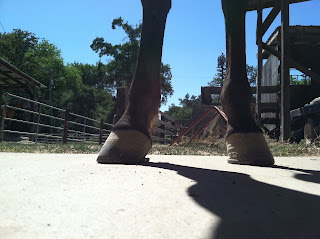So here are the results and pictures from Zoe's farrier/consult appointment. I included my notes which are sometimes just thoughts that I remembered. Again the appointment was like a college semester class all rolled into 2 hours. So my thoughts may be somewhat sketchy.
Zoe's heels were too long and
collapsing under her feet. Her toes were too long. The heels needed
to be pulled back and that was accomplished by cutting her heels.
The frog needed to be trimmed back some more first. Then trim the heels of
the foot back to the widest part of the frog. They had to be even on
both sides of the foot. Once the heels were set in the right place
-was somewhat trimmed a line was drawn (on the bottom of her foot) at the widest part of the
foot. Then a line was drawn where the heels started. The distance from the line in the middle to the toe was to be the same or close to
the distance from the line in the middle to the heels. If the toe end
was too long we could rasp some toe off or compensate by setting the
shoe back-rocker the shoe or rocker the toes to give better breakover.
The front of the foot needs to be straight from the corrent band to
the end of the toe-Zoe's was a little concaved (had a bump sticking out) so straightening that
out took some more toe off. The heels of the shoe extend 1/4” past
the end of the heels of the foot. The end of the heel of the shoe needs to be
straight under the middle of the leg. Also the edges of the heels of
the shoe should be as wide as the corent band at that part of the
foot. The whole point was to make the axis point of the foot (where
the weight came down from the leg) in the middle of the foot-so it
could be centered on each foot.
Hoof doesn't grow with excessive weight
on it. If the toe is too long the weight is on the heels. The heels
start to collapse under as the toe keeps growing. Zoe has a
high/low situation too. One foot is always in front as she bends
down to eat, it's always the same foot. That foot has even more
weight on the heel and even when she eventually stands straight she
tends to keep the weight on the back of her foot-making the problem
worse.
Zoe is also base narrow with her toes
out, meaning that she tends to keep her feet together esp the heels
with the toes pointing out (pigeon toed). This means her weight is mostly on the
inside of her foot, thus the inside of the foot doesn't grow as fast
as the outside of her foot. She is also a pretty much upright horse,
the pasturns don't slant down very much. Meaning there is more than
average the concussion on her foot as there isn't much “give” to
her stride. (Also makes for a bouncy ride)
The hind feet had the same problem.
Her left hind had more toe growing and the toe had more point than
the other one.
The corrent band is pretty straight and always
has been. That is good, you don't want a really “pushed up” corrent
band.
So everything is now balanced. It
doesn't mean that in 6 weeks it will still be balanced, but that's
why we all have appointments with our farriers to balance the feet
again. It makes me really wonder about barefoot trimming. It has to
be “right on” without the help of a shoe to compensate for
balance or compensate for comformational issues.
 | 

























Really interesting! What a good education. I can see in the side shots of her front feet that her coronet band really relaxed and straightened out in the quarters once the trim was improved. Back on the trail!
ReplyDelete